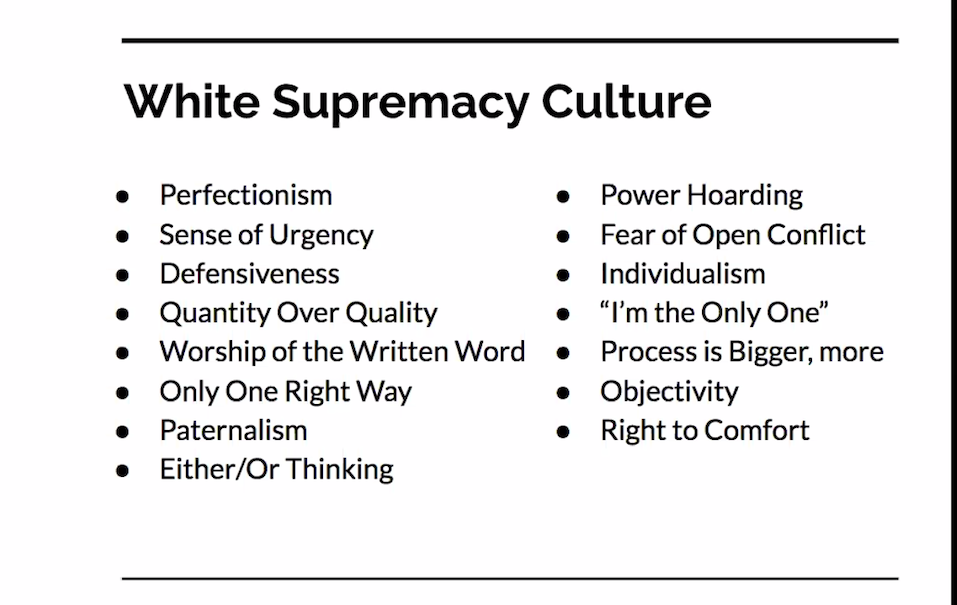By Anna Miller, a staff writer at RightsViews and a graduate student in ISHR’s Human Rights MA Program.
Note: This blog post addresses white supremacy in the United States only, though the ideology is alive globally.
On October 27, Dean Melanie Pagán and Dean Samantha Shapses, both of the School of International and Public Affairs, hosted a Deconstructing White Supremacy Workshop via Zoom. The workshop was open to the Columbia University community and fulfilled the Community Citizenship Requirement for Inclusion and Belonging for new Columbia students.
To kick off the workshop, the group screened Understanding White Supremacy (And How to Defeat It). This video explained how the roots of white supremacy are linked to colonization and racial biology. White colonizers assumed that people of color were inferior because they were “so easily conquered” and then presumed that “white skin people were perhaps more evolved than dark skin people.” While these ideas are objectively nonsensical, they did help form modern-day white supremacy and as such are important to understanding the roots of this ideology. The video also included a call to action and critical thought: “white supremacy is a part of American history and we need to own it and fully understand it before we can eradicate it.”
Next, Dean Pagán and Dean Shapses further defined white supremacy by offering a list of traits that are present in white supremacy culture. See a summary list below and learn more about the definitions of these terms.

Dean Pagán and Dean Shapses challenged the attendees to consider how these traits show up in everyday life, opening up the floor to discussion from participants. A key aspect of the workshop was taking the theory shared about white supremacy and applying it to our own lives. As such, I am going to detail how this workshop, and ideas of white supremacy culture, challenged me.
Two traits of white supremacy culture that I had a hard time reckoning with were the ones that were taught to me at a young age: perfectionism and sense of urgency. In my American Jewish family, success – particularly academic and career success – was held highest of all. To achieve success there was no room for inadequacy (perfectionism) and a high desire for quick results (sense of urgency). At first glance, these may seem like harmless characteristics. Yet, when the layers are peeled back it is clear that these traits stem from a fear of not measuring up to the white, American dream.
Like many Jews living in the U.S. post-Holocaust, my grandparents subdued their Jewish identity in search of American assimilation. By 1950, the U.S. was home to more than five million Jews and those individuals successfully made their way into the economic, political, academic, and cultural spheres. It is important to remember, though, that upward mobility was often used as a way to escape the persecution of white people. Surely, they can’t hate us if we are well-educated, rich, and pass as white people in society. Yet with acts of antisemitism at an all-time high in 2019, it is evident that striving for whiteness is not an antidote to the ongoing struggle of Jewish Americans today. Nor does the worship of whiteness ensure a safe, prosperous future for Black Americans. The White supremacy ideology is still at large, suppressing minority voices in order to enforce its omnipresence.
When it comes to white supremacy, law and policy is critical, but it will only take us so far. It is up to each one of us to examine our thoughts and actions for characteristics of white supremacy. If you have not already read Peggy McIntosh’s “White Privilege: Unpacking the Invisible Knapsack” – start there. Next, it is critical to stay aware of our environment and combat white supremacy by calling it out in class, in your social groups, and at home. As white supremacy is rooted in American culture, do not be surprised when you find it coming from the mouth of a loved one or the President of the United States. Once you have the education and resources, vigilance is required to work toward a country free from the clench of white supremacy.
Feature photo credit: Creative Commons // Backbone Campaign.

Well written article! Do you think perfectionism is exclusively an attribute of white supremacy or endemic to the human condition?